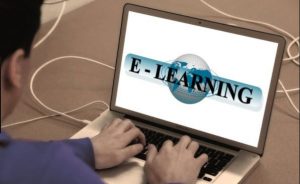
Free Illustration: Learn, Online, Laptop. WebSource: pixabay.com through Google Advanced Image Search.
To create a healthy climate for adult online learners, it is important to present the expectations in a positive manner on the first day of class. As you probably already know, it’s all about setting the tone early. Like face-to-face classrooms, virtual courses should have behavioral expectations, too. So, I recommend seven noble goals with behavioral expectations that foster emotionally intelligent online course rooms.
1. Be emotionally involved as a learner, share yourself online, and make it safe for others to do the same. Research has revealed that emotions are an essential part of who we are and are particularly important in social and written communication, attention, motivation, concentration, memory, creativity, behavior, health, and optimal information processing (Goleman, 1997; Jensen, 2000; Kusche & Greenberg, 1998; Sylwester, 1995). Consequently, researchers and educators have concluded that human emotions are a major force in learning.
2. Carefully read what is said and how it is presented by every learner in our online classroom. Be sensitive to your academic institution’s netiquette rules for online discussions. By paying attention to the tone and expression of our postings, we are able to increase awareness, thinking, empathy, and improve communication.
3. Please treat each other with the highest degree of respect and dignity. If you disagree with someone online, respond to the subject, not the person.
4. I am committed to open, frank, and insightful dialogue within our online courseroom. I would like for all learners to strive for that goal, too.
5. Diversity has many manifestations, including diversity of thought, opinion, and values. I expect all students to be respectful of our individual diversity and to refrain from inappropriate commentary.
6. Strive for a positive attitude within our virtual courseroom. Research has found that optimists are more motivated, more successful, have higher levels of achievement, plus significantly better physical and mental health (Seligman, 2006).
7. Finally, I encourage everyone to contribute to our online classroom by being supportive and by providing constructive feedback to ensure a productive and healthy learning environment.
References
Goleman, D. (1997). Emotional Intelligence: Why it can matter more than IQ. New York: Bantam Books.
Jensen, E. (2000). Brain-based learning: The new science of teaching & training. San Diego, CA: The Brain Store.
Kusche, C., & Greenberg, M. (1998). Integrating emotions and thinking in the classroom. Think, 9, 32-34.
Seligman, M. (2006). Learned optimism. How to change your mind and your life. New York: Vintage Books.
Sylwester, R. (1995). A celebration of neurons: An educator’s guide to the human brain. Alexandria, VA: Association for Supervision and Curriculum Development.
![Learning Management System in the form of binary code, 3D illustration. © [profit_image] / Adobe Stock](https://drdean.edublogs.org/files/2017/09/LMS-11j0xbp-zdojm5-300x200.jpg)